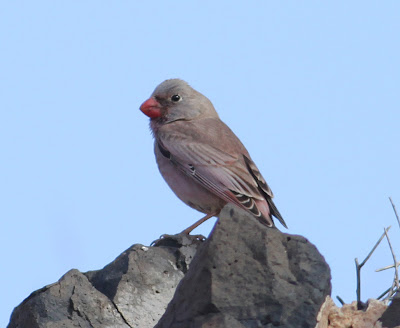Linnets have hung around all winter at Gulf Lane but Friday morning and with a gentle breeze from the south east came the first opportunity for a month or more to catch a few.
Earlier this week when I’d topped up the seed feed there’d been about 120 Linnets in the field, 8 or more Skylarks and 3 Stonechat dotted along the fence.
I met Andy at 0700 and within ten minutes we had the usual configuration of nets ready for action. The Linnets appeared ravenous as they dived into the area of the food from the off. Well into March, the hungry month for birds, there’s not much of their natural food left so our seed mix is doing the job.
We had a good catch of 23 Linnets but failed to catch a Skylark; despite two Skylarks being in the net, they both escaped before we laid a hand upon them. The Skylark is the Harrier Jump Jet of the bird world in being able to rise vertically from a standing start, even when partially enveloped by a mist net.
Skylark
Our catch of 23 Linnets comprised 8 first winter females, 2 adult females, 8 first winter males and 5 adult males. This brought our running total of new Linnets ringed during the Winter of 2017/18 to 237 individuals.
For only the second time at this site and with almost 450 Linnets behind us in two winters, we had only our second recapture – S800285 was ringed here on 2/11/2017 and recaptured today, but not in the intervening period.
A glance at the coffee stained field sheet from today shows a few large males with wing lengths of 83mm. This was surpassed by the very last adult male caught at 0930 with a whopping measurement and double checked via Andy as 87mm. Almost certainly this male will be from the Scottish and slightly larger sub species of Linnet, Linaria cannabina autochthona. By the way, and for those who collect such trivia, the old Scottish name for a Linnet is “lintie”.
Today's Field Sheet
Linnet
"Lintie"
And now to work for the next hour or so in transferring the data for those 23 birds into the new BTO online database DemOn.
DemOn - BTO
I knew that 87mm was a big one. DemOn gave me a validation warning.
"Wing-length queried as outside normal range of species – max 86mm"
"Validation warnings occurred when submitting the record. Please check the warnings, and click continue to save the record anyway. Please enter a comment for any warnings that require one before continuing. To go back and edit the record, click 'Cancel' ".
A ringer’s work is never done but back soon with more news, views and photos.
Linking today to World Bird Wednesday, Eileen's Blog and Anni's Blog.
"Wing-length queried as outside normal range of species – max 86mm"
"Validation warnings occurred when submitting the record. Please check the warnings, and click continue to save the record anyway. Please enter a comment for any warnings that require one before continuing. To go back and edit the record, click 'Cancel' ".
A ringer’s work is never done but back soon with more news, views and photos.
Linking today to World Bird Wednesday, Eileen's Blog and Anni's Blog.















































































